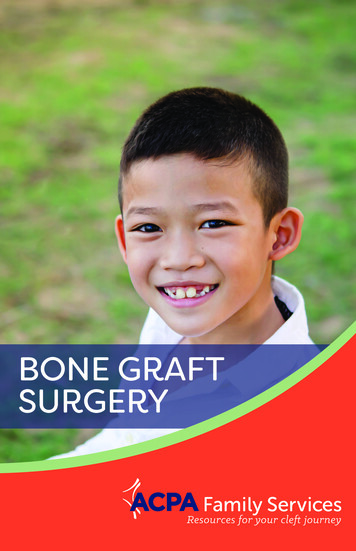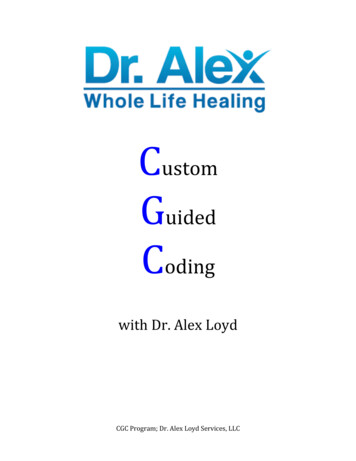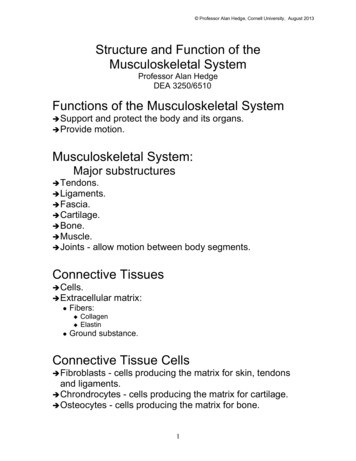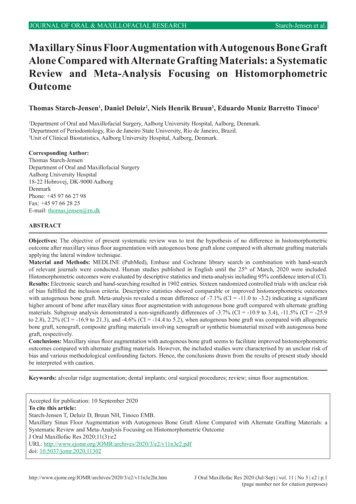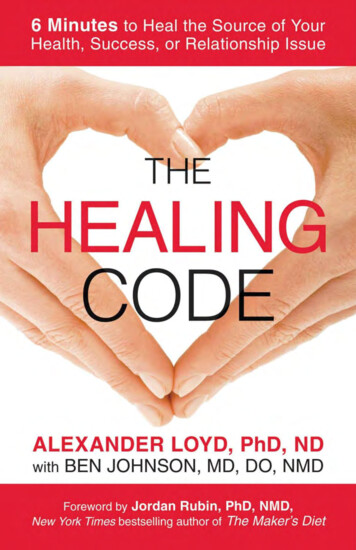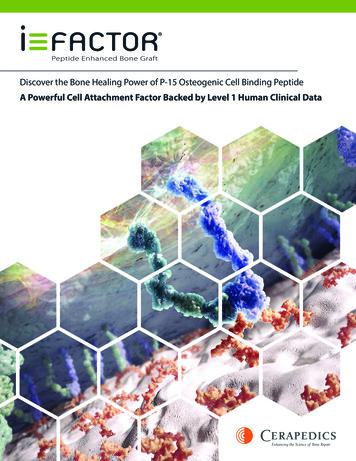
Transcription
Discover the Bone Healing Power of P-15 Osteogenic Cell Binding PeptideA Powerful Cell Attachment Factor Backed by Level 1 Human Clinical Data
i-FACTOR is a Drug-Device Combination Bone GraftDrugP-15PeptideATTACHMENTFACTOR DeviceCalciumPhosphateSCAFFOLD NE GRAFTi-FACTOR's Powerful Cell Attachment Capability: The P-15 PeptideP-15 Peptide is a naturally occurring chain of 15 aminoacids found on Type I collagen and is a critical cellbinding domain for bone-forming cells.The P-15 Peptide (Drug) is pharmacologicallymanufactured and bound to calcium phosphate(Device) delivery particles.This yields a high concentration of the peptide onthe graft and creates an abundance of P-15 Peptidebinding and anchoring surface receptor sites.Integrini-FACTOR has a Unique Mechanism of Actioni-FACTOR's mechanism of action increases the number of cells bound,cellular proliferation and protein/matrix production, without the risk ofectopic bone formation.1,2,3,4,16ATTRACTOsteogenic cells in the surroundingtissues have a high affinity for and arenaturally attracted to the P-15 Peptide.ATTACHOsteogenic cells attach via cellularsurface receptor integrins to the P-15Peptide, similar to a lock and key.ACTIVATEThe mechanical attachment activatesmultiple molecular processes that drivebone formation.2IntegrinP-15 Peptides
i-FACTOR has Level 1 Human Clinical EvidenceLevel 1Randomized controlledhuman clinical trialLevel 2Prospective cohort studyLevel 3Retrospective cohort studyFewer High Level Studies(Increased Cost and Quality)Number of StudiesPhysicians are encouraged to find the highest level ofevidence to support the safe and effective use of a product ina clinical setting. Evidence-based research studies can rangeanywhere between Level 1 to Level 6. i-FACTOR has publishedLevel 1 human clinical evidence whereas the majority of 510kbone grafts on the market have lower level studies.Level 4Case studiesLevel 5Mechanism-based reasoningLevel 6Animal studies, in vitro studiesMany Low Level Studies(Lower Cost and Quality)Only 2 FDA Class III PMA Approved Spinal Bone GraftsThere are three FDA regulatory pathways for orthobiologics: Class III, Class II 510k, and HCT/P (tissue based products). Class IIIdevices have the most rigorous pathway requiring a PMA Approved Level 1 Investigational Device Exemption (IDE) human clinicaltrial to bring the products to market.i-FACTOR has met the most robust FDA study requirements and is only the second Class III Drug-Device Combination bone graftapproved for the US Spine market. The only other spinal bone graft in this category is Medtronic's InfuseTM (BMP-2). The majority ofbone grafts on the market are cleared via the 510k pathway.CLASS III2 PRODUCTSCLASS II400 PRODUCTSHCT/Ps 10 PRODUCTSIDE - LARGE HUMAN CLINICAL STUDY2PMA APPROVAL - DEMONSTRATE SAFETY & EFFICACY IN HUMANS510k - ANIMAL DATA0 SUBSTANTIALLY EQUIVALENT TO PREDICATE DEVICE400 1NO FDA REVIEWNO ANIMAL OR HUMAN TESTING REQUIRED3
i-FACTOR has a PMA Approval based on an IDE Human Clinical Study5,6Prospective, randomized, controlled, statistically powered, multicenter trialLevel 1 human clinical data from 319 patientsFDA approval based on IDE study (Investigational Device Exemption)One year data published 2016 in Spine demonstrating a fusion rate of 89.0%Two year data published 2018 in Neurosurgery demonstrating a fusion rate of 97.3%Statistical superiority vs. autograft in overall clinical success at one and two yearsi-FACTOR has Proven Clinical Superiority vs. ICALLYSUPERIOR7774% Success936960%7069575640%20%0%p 0.4220p 0.2195Fusion Successi-FACTOR 12 monthsp 0.2907p 0.1804NDI Successp 0.8123p 0.6944p 0.3085Neurological SuccessAutograft 12 monthsi-FACTOR 24 monthsp 0.1379Safety Successp 0.0382p 0.0302Overall SuccessAutograft 24 monthsi-FACTOR was demonstrated to be statistically superior to autograft inoverall clinical success at one year and two years.5,6i-FACTOR is the only spinal bone graft on the market that can make this claim.4
Misconceptions of ACDF Fusion RatesACDF fusion rates are commonly over reported in the literature whereas studies with more stringent fusion criteria reveal lowerfusion rates.7 This is clearly demonstrated in the published ACDF fusion rates in the control arms of Cervical Total Disc Replacement(TDR) FDA mandated studies that are Level 1, prospective, randomized, controlled and blinded.!ACDF fusion rates are often over reported in the literaturein comparison to IDE Study ACDF fusion rates.i-FACTOR ACDF Fusion Rates are Higher than theACDF Control Arms in All Cervical TDR IDE Studies5,6 In all Cervical TDR IDE studies, the control arms were single level ACDFs with allografts, there was no artificial disc. A fair comparison of fusion rates is to assess those control arm fusion rates with i-FACTOR’s IDE study fusion rates becausethe i-FACTOR IDE Study design was also a single level ACDF with i-FACTOR in a cortical allograft ring. As shown in the chart below, these TDR study control arm ACDF fusion rates are as low as 78.6% and up to 94.3% whichare all consistently lower than i-FACTOR’s 24 month fusion rate of 97.3%.i-FACTOR Level 1 IDE Studyi-FACTOR Test Arm Fusion Rate 24 mosTest Arm Designi-FACTOR5,697.3%i-FACTOR with Allograft RingTDR Level 1 IDE StudyAllograft Control Arm Fusion Rate 24 mosControl Arm DesignBryan Cervical Disc94.3%AllograftPCM Cervical Disc992.1%Tricortical AllograftPro-Disc C1090.2%Allograft and Local Bone89.3%Corticocancellous Allograft89.1%Structural AllograftKineflex C Artificial Disc82.0%Corticocancellous AllograftM6-C78.6%Corticocancellous Allograft and Local Bone8MOBI-C/TBI Study11,12Globus Secure-C131415LEVEL 1 IDE STUDYFUSION RATE OF 97.3%5,65
i-FACTOR is TOPICBONEFORMATIONOnly grows bone in a bony environment, no evidence of ectopic bone formation16Over 100k procedures worldwide since 2008Clinical experience outside US since 2008, in US since 2015IDE Study demonstrated no difference in adverse events vs. autograft5,6i-FACTOR is PredictableHigh Fusion Rates12 months24 months89.0%97.3%IDE Study: 3 monthsIDE Study: 6 monthsIDE Study: 12 monthsi-FACTOR has a proven safety profile equivalent to autograft.5,6i-FACTOR only grows bone in the presence of bone forming cells.6
Fusion Characteristics Similar to Mature and Healthy BoneTo evaluate the quality of bone within the interbody space, 3D CT imaging technology from a patient in the IDE study determinedthat the porosity, trabecular orientation and structure of the bone that i-FACTOR developed was characteristic of matureand healthy normal bone within six months.17Post-op3 Months6 MonthsIndicationi-FACTOR Peptide Enhanced Bone Graft isindicated for use in skeletally mature patients forreconstruction of a degenerated cervical disc atone level from C3-C4 to C6-C7 following singlelevel discectomy for intractable radiculopathy(arm pain and/or a neurological deficit), withor without neck pain, or myelopathy due to asingle-level abnormality localized to the discspace, and corresponding to at least one of thefollowing conditions confirmed by radiographicimaging (CT, MRI, X-rays): herniated nucleuspulposus, spondylosis (defined by the presenceof osteophytes), and/or visible loss of disc heightas compared to adjacent levels, after failureof at least 6 weeks of conservative treatment.i-FACTOR Peptide Enhanced Bone Graft mustbe used inside an allograft bone ring and withsupplemental anterior plate fixation.Available Sizes700-010i-FACTOR Putty1.0cc700-025i-FACTOR Putty2.5cc700-050i-FACTOR Putty5.0cc7
Cerapedics is an advanced orthobiologics company focused on developing and commercializing its proprietary small peptide (P-15) technologyplatform. i-FACTOR Peptide Enhanced Bone Graft is the only biologic bone graft in orthopaedics that incorporates P-15 osteogenic cell bindingpeptide to stimulate the natural bone healing process. This novel mechanism of action is designed to support safer and more predictable boneformation compared to commercially available bone growth .15.16.17.Hennessy KM, Pollot BE, Clem WC, Phipps MC, Sawyer AA, Culpepper BK, Bellis SL. The effect of collagen 1 mimetic peptides on mesenchymal stem cells adhesion and differentiation, and on bone formation athydroxyapatite surfaces. Biomaterials. 2009 Apr; 30(10): 1898-909.Nguyen H, Qian JJ, Bhatnagar RS, Li S. Enhanced cell attachment and osteoblastic activity by P-15 peptide-coated matrix in hydrogels. Biochem Biophys Res Commun. 2003 Nov 7;311(1):179-86.Yang XB, Bhatnagar RS, Li S, Oreffo RO. Biomimetic collagen scaffolds for human bone cell growth and differentiation. Tissue Eng. 2004 Jul-Aug;10(7-8):1148-59.Qian JJ, Bhatnagar RS. Enhanced cell attachment to anorganic bone mineral in the presence of a synthetic peptide related to collagen. J Biomed Mater Res. 1996 Aug;31(4):545-54.Arnold PM, Sasso RC, Janssen ME, Fehlings MG, Smucker JD, Vaccaro AR, Heary RF, Patel AL, Goulet B, Kalfas IH, Kopjar B. Efficacy of i-Factor Bone Graft versus Autograft in Anterior Cervical Disectomy and Fusion.Results of the Prospective Randomized Single-blinded Food and Drug Administration Investigational Device Exemption Study. Spine. 2016; 41(13): 1075-1083.Arnold PM, Sasso RC, Janssen ME, Fehlings MG, Heary RF, Vaccaro AR, Kopjar B. i-FACTOR Bone Graft vs Autograft in Anterior Cervical Discectomy and Fusion: 2-Year Follow-up of the Randomized Single-Blinded Foodand Drug Administration Investigational Device Exemption Study. (2018) Neurosurgery; Vol-83(3): pages 377-384.Sethi N1, Devney J, Steiner HL, Riew KD. Diagnosing cervical fusion: a comprehensive literature review. Asian Spine Journal. 2008 Dec;2(2):127-43.Heller JG, et al. Comparison of BRYAN cervical disc arthroplasty with anterior cervical decompression and fusion: clinical and radiographic results of a randomized, controlled, clinical trial. Spine. 2009 Jan 15; 34(2): 101-7.Phillips FM, et al. A Prospective, Randomized, Controlled Clinical Investigation Comparing PCM Cervical Disc Arthroplasty with Anterior Cervical Discectomy and Fusion: 2-Year Results from the US FDA IDE Clinical Trial.Spine. 2013 Jul; 38(15): E907-18.Murrey D, et al. Results of the prospective, randomized, controlled multicenter Food and Drug Administration investigational device exemption study of the ProDisc-C total disc replacement versus anterior discectomyand fusion for the treatment of 1-level symptomatic cervical disc disease. Spine J. 2009 Apr; 9(4): 275-86.Hisey MS, Bae HW, Davis R, Gaede S, Hoffman G, Kim K, et al. Multi-center, prospective, randomized, controlled investigational device exemption clinical trial comparing Mobi-C Cervical Artificial Disc to anteriordiscectomy and fusion in the treatment of symptomatic degenerative disc disease in the cervical spine. Int J Spine Surg. 2014; 8.Zigler JE, Rogers RW, Ohnmeiss DD, Comparison of 1-Level Versus 2-Level Anterior Cervical Discectomy and Fusion: Clinical and Radiographic Follow-Up at 60 Months. Spine. 2016 March; 41(6): 463-9.Vaccaro A, et al. Clinical outcomes with selectively constrained SECURE-C cervical disc arthroplasty: two-year results from a prospective, randomized, controlled, multicenter investigational device exemption study.Spine. 2013 Dec 15; 38(26): 2227-39.Coric D, Nunley PD, Guyer RD, Musante D, Carmody CN, Gordon CR, et al. Prospective, randomized, multicenter study of cervical arthroplasty: 269 patients from the Kineflex C artificial disc investigational deviceexemption study with a minimum 2-year follow-up. Journal of Neurosurgery: Spine. 2011 Oct; 15(4): 348-58.PMA P170036: FDA Summary of Safety and Effectiveness Data www.accessdata.fda.gov/cdrh docs/pdf17/P170036B.pdf.Internal Data Report.Kesteloot G, Parish AJB, Johnson S, McNally DS. Three Dimensional remodelling of i-FACTOR Peptide Enhanced Bone Graft substitute in cervical fusions. Accepted as poster, Annual Scientific Meeting of the BelgianSociety of Neurosurgery, March 2016.Corporate Headquarters11025 Dover Street, Suite 1600 Westminster, CO 80021 USAP: (303) 974-6275E: 97 Internationally availableEurope, Middle East, Africa, Asia Pacific and CanadaLondon, EnglandE: emea@cerapedics.com 2020 Cerapedics, Inc.All rights reserved.ML-0594 06/20
Bryan Cervical Disc8 94.3% Allograft PCM Cervical Disc9 92.1% Tricortical Allograft Pro-Disc C10 90.2% Allograft and Local Bone MOBI-C/TBI Study11,12 89.3% Corticocancellous Allograft Globus Secure-C13 89.1% Structural Allograft Kineflex C Artificial Disc14 82.0% Corticocancellous Allograft M6-C15 78.6% Corticocancellous Allograft and Local Bone


